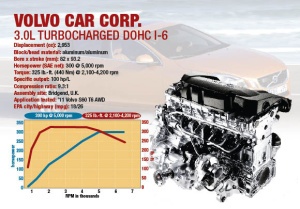One of the things most often found in forums and online communities of car enthusiasts is a discussion on horsepower and torque, and their relationships to one another. There is quite a lot of misinformation that travels the circuit, and when posed as fact, that misinformation can be very destructive to the understanding of what power actually is.
Before we begin, I want to make a point about unit relationships and conversions. Because the metric system is most often used in scientific studies, and because not all readers will be familiar with US customary conventions, 1 horsepower is roughly equivalent to 0.746 kilowatts and 1 pound-foot is roughly equivalent to 1.36 newton meters.
When we talk about the motive power of an engine, we are describing a relationship between work, time, and mass. We all know that engines are typically marketed based on two values- power, and torque. Let's first examine torque- as we will soon see, power is related directly to torque and engine rotational speed, commonly measured in RPM.
The transmission uses gear ratios
 The torque rating of an engine is a peak figure. That is, an engine is tested across its entire RPM range, and the highest torque produced is what is given as the torque figure. This is why a torque figure is often stated as "'X' pound-feet of torque at 'Y' RPM", or something similar. The torque figure is a means of explaining the force applied that would stall the engine. For example, if we see that a small engine is rated for 10 pound-feet of torque at 1000 RPM, and we were to run the engine at that same speed, we would be able to stall that engine by applying a torque of 10 pounds at one foot from the crankshaft center, or 1 pound at 10 feet from the crankshaft center (as long as pounds x feet = 10, the result will be the same). Suppose we were able to operate a 10 foot long lever on the end of this crankshaft. If we applied one pound of force at the end of that crankshaft in the direction opposite of rotation, we would stall the engine. You might be saying "But wait! My car engine produces 100 foot-pounds! How can it possibly pull my 2500 pound car?" The transmission and differential use gear ratios that compound to decrease the speed and increase the torque in proportion: if 1st gear is 4.0:1 and your differential final drive is also 4.0:1, your total gear ratio is 16.0:1 at the wheels (giving you 1600 foot pounds, and 1/16 of the engine RPM). Isn't that cool?!
The torque rating of an engine is a peak figure. That is, an engine is tested across its entire RPM range, and the highest torque produced is what is given as the torque figure. This is why a torque figure is often stated as "'X' pound-feet of torque at 'Y' RPM", or something similar. The torque figure is a means of explaining the force applied that would stall the engine. For example, if we see that a small engine is rated for 10 pound-feet of torque at 1000 RPM, and we were to run the engine at that same speed, we would be able to stall that engine by applying a torque of 10 pounds at one foot from the crankshaft center, or 1 pound at 10 feet from the crankshaft center (as long as pounds x feet = 10, the result will be the same). Suppose we were able to operate a 10 foot long lever on the end of this crankshaft. If we applied one pound of force at the end of that crankshaft in the direction opposite of rotation, we would stall the engine. You might be saying "But wait! My car engine produces 100 foot-pounds! How can it possibly pull my 2500 pound car?" The transmission and differential use gear ratios that compound to decrease the speed and increase the torque in proportion: if 1st gear is 4.0:1 and your differential final drive is also 4.0:1, your total gear ratio is 16.0:1 at the wheels (giving you 1600 foot pounds, and 1/16 of the engine RPM). Isn't that cool?!
Power is a relationship
At this point we understand that the torque figure is the peak rotational force the engine is able to produce; the force that the engine is applying to move the vehicle and do work. Power, on the other hand, is a relationship between torque and engine RPM. Horsepower the major customary unit for power is defined as follows:
1 Horsepower = 33,000 pound-feet / minute
Recall from our example before that our small engine produces 10 pound-feet of torque at 1000 RPM. In order to keep our units simple, we will take that to mean a force of 10 pounds at one foot from the crank center. At 1000 RPM, the tip of that 1 foot lever will have traveled:
2 * π * 1 foot = approx 6.28 feet/revolution
1000 * 6.28 = 6280 feet/minute
Therefore, we can see that the equation for engine power in this example will be:
10 pounds * 6280 feet / minute = 62800 pound-feet / minute
= 1.90 Horsepower @ 1000 RPM
Peak power & torque are never listed at the same engine speed
 Clearly, this does not sound very impressive. Even most lawn mowers make more than 1.90 horsepower. So what gives? You may have noticed that peak power and peak torque are almost never listed at the same engine speed. There will be a different point in the engine's torque curve where the relationship between torque and RPM will produce a higher power figure. As another exercise, let's say that this engine has a peak power of 7 HP at 4000 RPM. What will the torque figure be at that speed?
Clearly, this does not sound very impressive. Even most lawn mowers make more than 1.90 horsepower. So what gives? You may have noticed that peak power and peak torque are almost never listed at the same engine speed. There will be a different point in the engine's torque curve where the relationship between torque and RPM will produce a higher power figure. As another exercise, let's say that this engine has a peak power of 7 HP at 4000 RPM. What will the torque figure be at that speed?
7 horsepower = 231,000 pound-feet / minute
We know that at 1 foot from the crank, we are rotating at 6.28 feet / revolution
6.28 feet / revolution * 4000 RPM = 25120 feet / minute
231,000 pound - feet / minute ÷ 25120 feet / minute = 9.20 pounds
9.20 pounds * 1 foot = 9.20 pound-feet
How about that! Our engine produces 10 pound-feet at 1000 RPM and 9.20 pound-feet at 4000 RPM. What a remarkably flat torque curve! This engine must be a diesel! (Of course, this was a hypothetical engine that I made up on the spot, but if such an engine exists, I'd love to have one for my lawn mower.)
The metric calculations are much the same (however, they are markedly easier because of the decimal nature of the metric system).
The physical concept known as "Jerk"
This dispels the common adage that torque is that "seat of your pants" sensation during hard acceleration. Torque is nothing more than the rotational force the engine can provide at a given RPM. That "seat of your pants" sensation is actually a manifestation of a physical concept known as "Jerk" (or the third derivative of position for you Calculus nuts out there). This is the rate of change of acceleration. It is related to torque, but it's also related to plenty of other parameters , and so it cannot be generalized as being completely based on torque. On the other hand, watching videos of tractor-pulls and truck races, you can often see the entire frame of the truck twist during extremely hard acceleration - this is a good visualization of the force we call torque.
Go forth and disperse this information among the auto enthusiasts in your life! Together we can unravel years of internet misinformation - because knowing is half the battle!
About the Author: Dan Bullmore
 Dan Bullmore is a physicist and engineer from Houston, TX. Preferring the old to the new, Dan has owned many examples of Mercedes and Volvo vehicles and has devoted much of his time to maintaining and understanding them.
Dan Bullmore is a physicist and engineer from Houston, TX. Preferring the old to the new, Dan has owned many examples of Mercedes and Volvo vehicles and has devoted much of his time to maintaining and understanding them.











